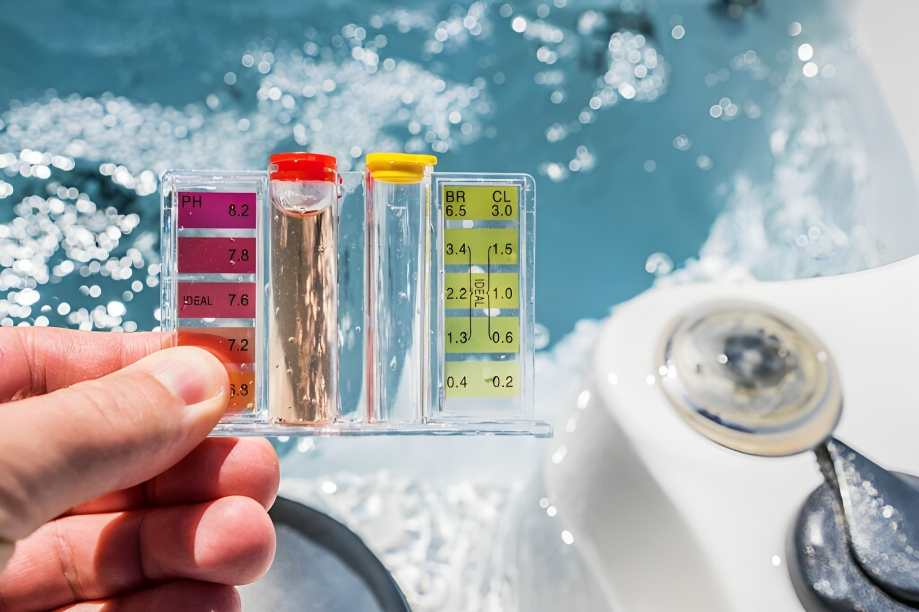When it comes to chemicals for your hot tub, most people are skeptical. And that’s ok because the modern world is full of dangerous chemicals you don’t want to deal with. Generally, there are tons of different kinds that you don’t even need, but since they can just confuse you, we thought we’d do research on what chemicals are necessary for your hot tub, how to use and store them.
🎁 Bonus: Also don’t neglect to check what are the 9 must-have chemicals for your hot tub and why!
And now we are ready to gladly present you with the results of our work. Prepare for opening a new, exciting chemical world for yourself!
What Is Hot Tub Chemical Kit And Its Purpose
A hot tub chemical kit is a collection of products designed to kill bacteria and viruses, maintain a clean and sanitary environment, and prevent corrosion and other problems. The purpose of a hot tub chemical kit is to keep your hot tub clean, safe, and well-maintained, so you can enjoy it for many years. Since properly using the chemicals included in the kit is critical to achieving these goals, we’ll do everything we can to lay the groundwork for you.
The Importance Of Chemicals
The hot tub is a great way to relax and enjoy yourself; its maintenance is the key to safe and continuous relaxation. Despite various rumors, it’s hard to deny the importance of chemicals for your hot tub. But it’s important to know what chemicals you need, as there are tons of unnecessary ones. With the right knowledge, a chemical kit can help your hot tub in many ways:
- Keep your water in balance (which creates safe conditions for your skin);
- Achieve a higher level of cleanliness;
- Protecting your hot tub’s details from corrosion, etc.
Is Using Chemical Kit Safe for You and Your Hot Tub?
We know this question can make you very anxious, so get ready to learn the truth. As the saying goes, the dose makes the poison. And we wholeheartedly agree. With the right approach, chemicals can improve your safety and the overall health of your spa. But if you use them carelessly, this can end badly. If you want to learn how to properly use chemicals for the best results, you can simply jump to becoming a chemist chapter.
Inflatable Hot Tub Chemical Kit: Are There Any Differences?
Maybe you’re an inflatable hot tub owner, and you’re curious about chemicals: could they damage your hot tub? Chemicals affect the water in your hot tub, not the material. In addition, this is a maintenance hot tub chemical kit, meaning it’s created to protect your water and hot tub.
The chemicals used for inflatable hot tubs and hard shell hot tubs are generally the same, as both require similar maintenance routines to keep the water clean and healthy. However, the main difference between the two is in the number of chemicals needed.
Inflatable hot tubs have a smaller water volume and typically require fewer chemicals compared to hard-shell hot tubs, which have a larger water volume. Additionally, as the water can become contaminated more quickly in your inflatable hot tub due to its smaller size, you’ll need to change it more often.
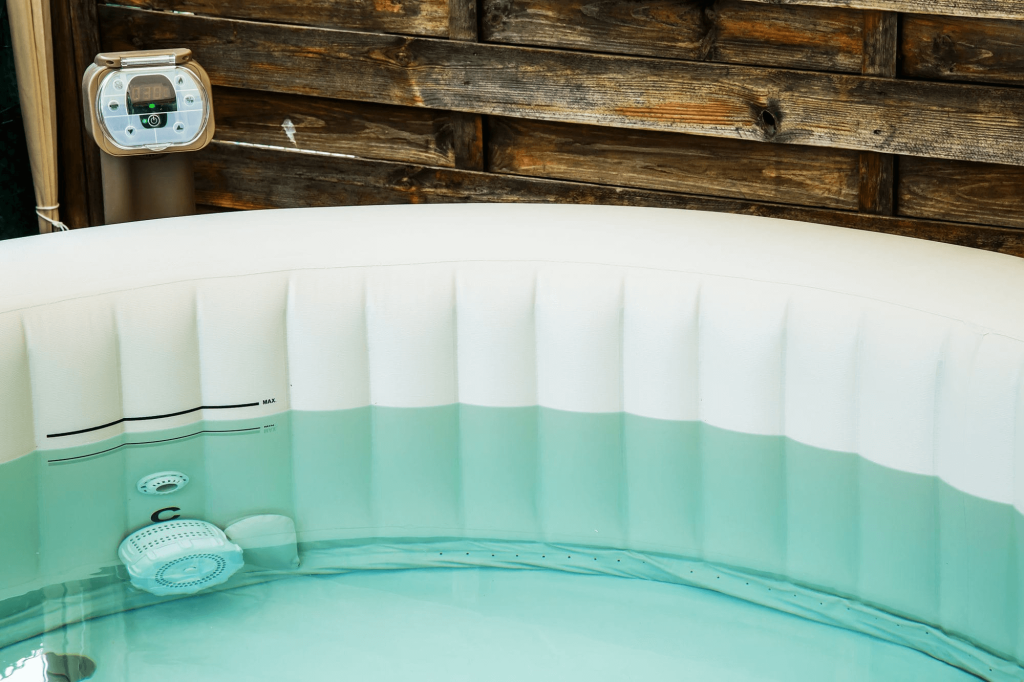
Hot Tub Chemical Starter Kit Unboxing: Does It Include Everything You Need?
When you purchase a hot tub chemical kit, you want to get everything you need. But is it a wise investment? Let’s investigate!
There are two types of hot tub chemical starter kits available, categorized by their primary sanitizers: chlorine and bromine. These kits often include a calcium increaser, total alkalinity increaser, pH plus and minus, and sanitizer (chlorine or bromine). Occasionally, you can apply spa shock, spa clarifier, flush line product, and metal and foam remover. It’s important to note that many kits either contain unnecessary chemicals to increase the price of the kit or, on the opposite, exclude crucial components like sanitizer or test strips.
To sum up, we suggest you look at the table that can help you when shopping.
| Necessary | Optional |
| Test strips Sanitizer pH increaser and decreaser Total alkalinity increaser Spa shock Flush line product | Metal remover Foam remover Filter cleaner Spa clarifier |
Curious about why they are so important, jump to the next section!
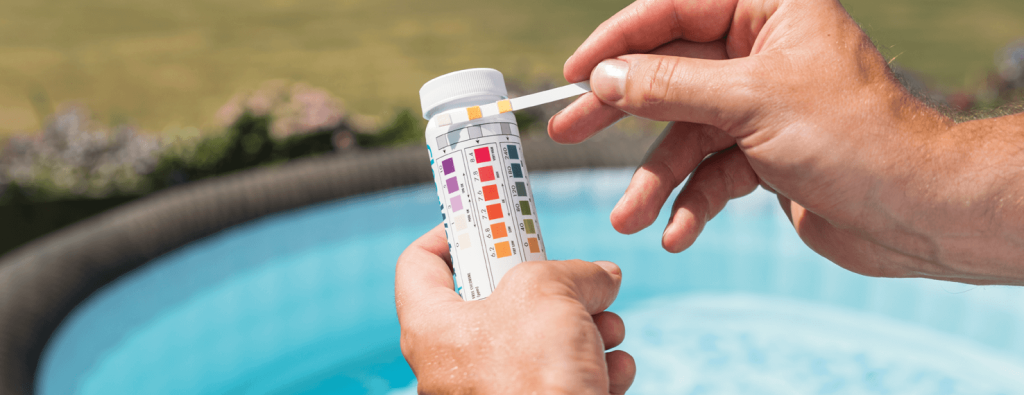
Do Not Overpay: Crucial Hot Tub Chemicals And What Do They Do
As you now understand that a hot tub chemical starter kit isn’t always a good option (as it can include chemicals you don’t need) let us provide you with a guide on how chemicals you need work.
- Sanitizer is a chemical used to eliminate or limit the growth of bacteria. Without a sanitizer, the water in a hot tub can become contaminated, posing a health risk to users. As mentioned earlier, there are two types of sanitizers commonly used in hot tubs: Chlorine and Bromine. What are the differences? Which is better for you? We knew this would be of interest to you!
| Is best for outdoor hot tubs. It offers great value for its price, is easy to use, and is very effective at killing bacteria. | Is ideal for indoor hot tubs. Also, bromine lasts longer and has no characteristic odor (like chlorine). Bromine is a suitable alternative to chlorine, as it feels better on the skin and has lower pH levels. This makes it easier to maintain balanced water chemistry. |
| Chlorine has a specific smell. In addition, it can cause dryness, itching, redness of the skin, and irritation of the eyes. | Besides working slower, bromine loses its efficiency under direct sunlight. In addition, the price is a bit higher compared to chlorine. |
- pH Up and Down. The pH is a measure of the acidity of the water in your spa. These chemicals are used to adjust the pH of the water. The ideal pH level for your hot tub is between 7.2 to 7.8.
- Total Alkalinity Increaser. Total alkalinity (TA) indicates how well your water resists acids. TA and pH are closely related, and since there is no product to lower the TA level, the best method is to lower it with a pH decreaser. High TA levels can cause difficulty in adjusting pH, which in turn can lead to cloudy water. On the other hand, lower levels of TA can cause the pH to fluctuate rapidly, making it difficult to maintain proper control.
- Spa Shock is a strong oxidant that is frequently used to remove organic pollutants from hot tub water, including body oils, perspiration, and cosmetics. These contaminants can cause skin irritation, odor problems, and cloudy or discolored water. By quickly oxidizing the pollutants, spa shock helps in restoring the water’s clarity and quality.
- Calcium Increaser. It dissolves in the water and raises the calcium content. Maintaining an appropriate calcium level is essential, as low levels of calcium can result in the corrosion of the hot tub’s components due to the water’s acidic properties. Skin and eye discomfort can also result from low calcium levels. But if the calcium levels are too high it can cause scale formation on surfaces, cloudy water, and reduce the effectiveness of the sanitizers.
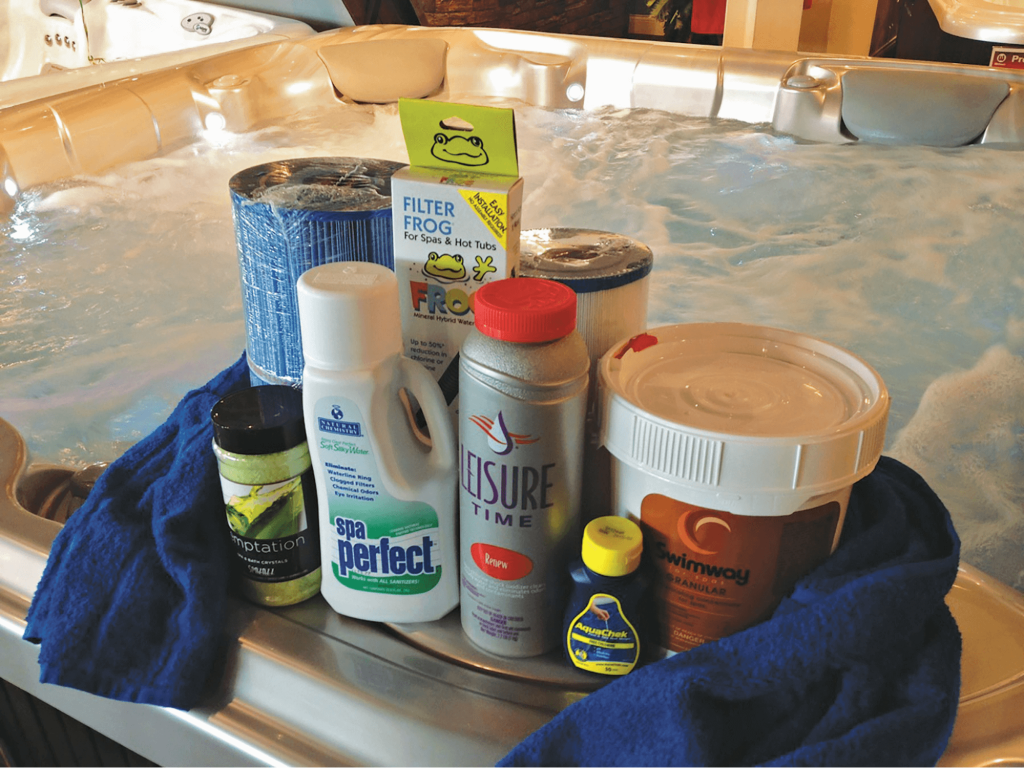
Becoming A Chemist: Quantity And Frequency Of Use
Once you have your chemicals ready for use, just follow our instructions to get everything right:
- Test. Firstly, you should test your water with test strips. That will provide you with a current water condition, so you will know what to do next (we recommend you test the water before and after each spa session);
- Sanitizer — chlorine or bromine. The ideal level for chlorine is 1-3 ppm, while for bromine is 3-5 ppm (disinfect your hot tub after each use for the best protection);
- Hot Tub Shock. Its name totally represents what it does. By shocking your hot tub, you replenish and revitalize the sanitizer levels. Weekly shocking is a good solution for preventing issues with water pollutants. As a result, this simple action can save you from potential problems in the future.
- Alkalinity Increaser, pH Decreaser, pH Increaser. Maintaining an appropriate alkalinity level is critical to your spa’s water chemistry. Aim for a level between 100 and 150 parts per million (ppm) to ensure the acidity of the water is properly balanced. A pH of 7.2 to 7.8 is ideal, as a lower pH can potentially cause corrosion problems in your spa. However, if it’s higher, it can be dangerous to your skin and eyes;
- Calcium Hardness Increaser is used to achieve an appropriate calcium hardness level, usually between 200 and 400 ppm. Lowering the calcium hardness level in your spa can be a difficult task as there are no products available for this purpose. In such a situation, it’s best to drain the spa and refill it with fresh water. This will maintain the chemical balance of the water and ensure efficient operation of the spa;
- Flush Line Cleaner. You can not finish your shopping without a flush line cleaner to remove accumulated dirt and debris in your hot tub. After use, you should drain all the water. Remember to do this every 3 – 4 months to ensure your hot tub stays in good condition for an extended period of time.
Everyone knows: “A clean hot tub not only looks great, but it also provides a healthier and more enjoyable spa experience.”
Note: Before beginning any chemical processes, ensure your safety by donning gloves, goggles, and a mask (if needed). Also, avoid combining chemicals as this might be harmful.
Chemicals should be applied one at a time directly in water, 20 minutes apart. While adding chemicals, you should turn on your jets to make sure they are promptly and uniformly dissolved.
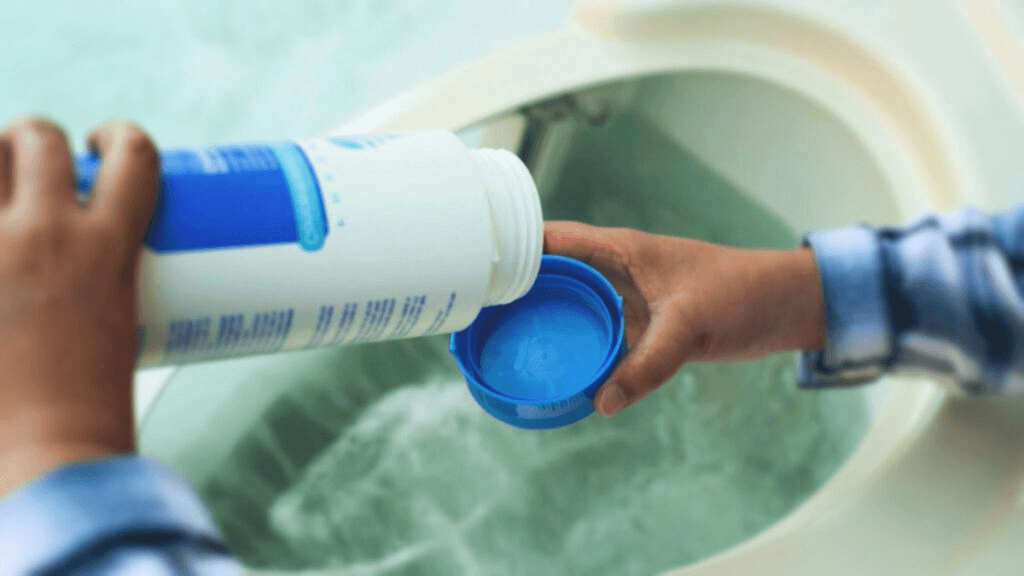
Your Spa Chemical Kit Wants Comfort Too: Store Tips
As the hot tub chemical kit is taking care of your hot tub, you should take care of it. Although there are some tricks, it’s not challenging. If stored improperly, chemicals tend to degrade their quality. We want you to select the best option while also utilizing it to its maximum. Also, storage shouldn’t be overlooked because it may compromise your safety. You should pay attention to the following to preserve your chemicals’ efficacy:
- Temperature. Chemicals should be stored between 55 °F and 70 °F (12 °C and 20 °C), according to manufacturers. Avoid direct sunlight as it will have a negative impact.
- Place. You should find a dry location to store your chemicals.
- While chemicals must be stored appropriately to prevent corroding one another (don’t set liquid chemicals on top of dry ones, for example), placement is crucial.
- Children. Chemicals may seriously hurt a child if they are stored in a place where they are easily accessible, since they can harm you (which is why we advised using gloves, etc.).
Conclusion
Congratulations on your graduation from spa chemistry! The hot tub is an excellent tool to escape from the stress of everyday life. But to make it last, proper maintenance is essential.
Being able to form the right hot tub chemical kit is key to simplifying your hot tub maintenance routine, as it allows you to maintain a clean and healthy hot tub almost effortlessly throughout the year.
We sincerely hope that our article has helped you put your worries aside so that you will be able to take excellent care of your hot tub.
FAQ
🧪 What chemicals do I need to start up my hot tub?
To get maximum safety you will need a pH increaser and decreaser, sanitizer (chlorine or bromine), and total alkalinity increaser. But we suggest you add spa shock, flush line products, and filter deep cleaner over time.
🏆 What are the best chemicals to use in the hot tub?
The most popular and important chemical for your hot tub is a sanitizer — chlorine, bromine, or biguanides (similar to biocide, this is a chlorine-free sanitizing chemical).
🔬 How do hot tub chemicals work?
Hot tub chemicals’ mission is to rid the water of bacteria (such as your body oils, dead skin cells, etc.). Also, their task is to keep your water well-balanced, so it can stay in the hot tub much longer without refilling.
🔎 Can I use the hot tub once without chemicals?
If you use your hot tub without chemicals (or use them in the wrong way) it promotes bacteria development. As the water needs to be circulated to keep itself clean, it keeps circulating with bacteria which isn’t safe for you.


